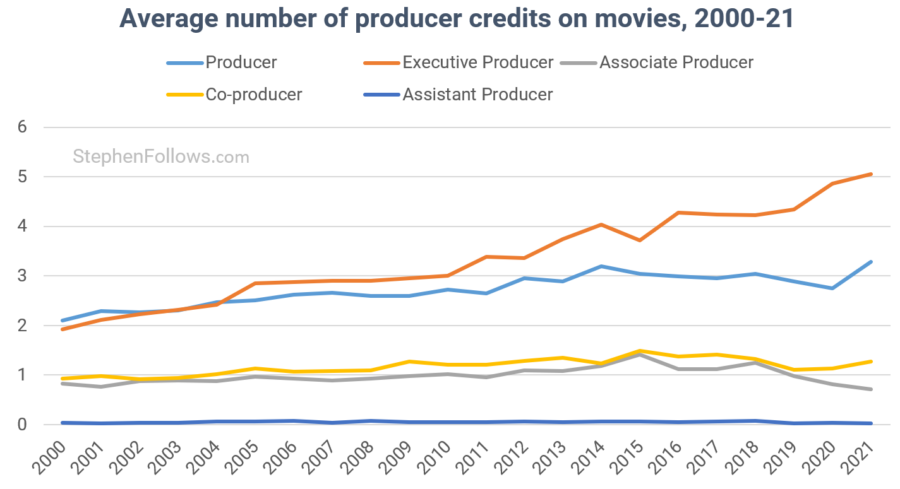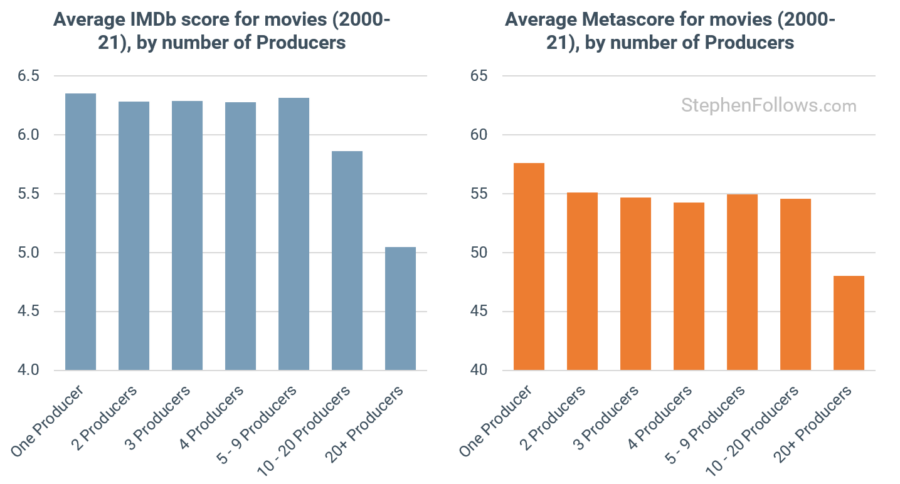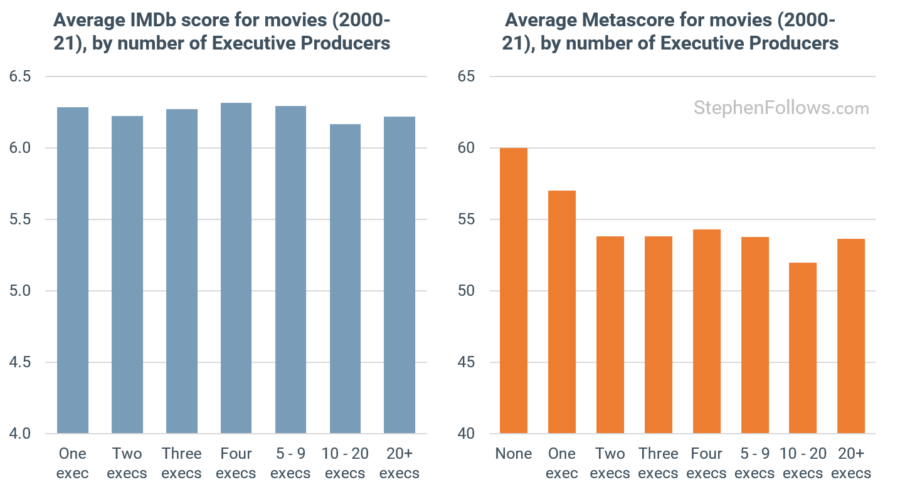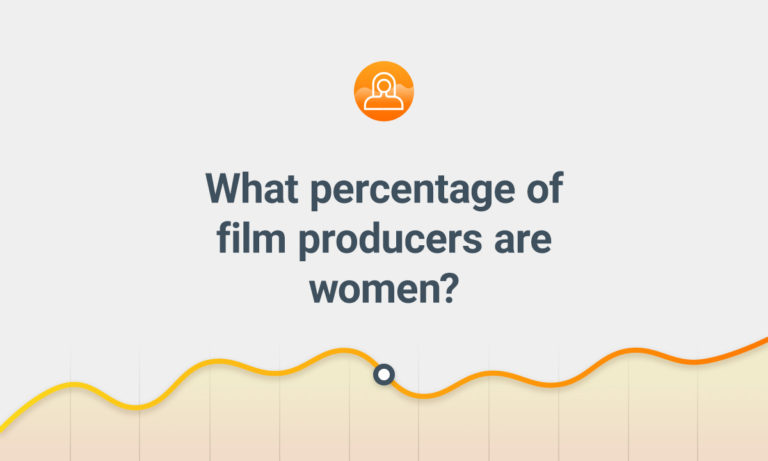Last week I investigated if there was a link between the number of people thanked in a movie’s credits and the quality of the movie. This week I am testing a related industry truism; namely, that a greater number of producers is an indication that a movie is more likely to be bad
I have in the past shown that movies are increasingly less likely to generate a profit as the number of producers increases. But what of quality?
Does having more people on hand to share the producing duties result in better movies? Or do too many producers spoil the set?
To answer this I studied 75,903 producing credits, across 8,415 movies released between 2000 and 2021 (details of the exact criteria in the notes at the end of the article).
How many producers do you need?
Let’s start by looking at how many producers are credited on the average movie.
Across all the films I studied, and all flavours of producing credit, the average movie had nine producers.
That may instinctively feel like a lot and that’s because, well, it is! It would be hard to have nine people working in unison, each taking on a ninth of the producing duties.
In reality, there are a number of different types of producing credit, each with differing levels of control and with different areas of focus.
The primary producing credit is that of “Producer”, with the average film having 2.7 of such Producers. When we split this out by year, we discover that the number of Producers on a movie has been increasing over the past two decades. In 2000 the figure sat at 2.1 but this had increased to 3.3 by 2021.
However, this increase is dwarfed by the epic rise in people receiving an Executive Producer credit. In 2000 the average movie had 1.9 Execs whereas by 2021 that had more than doubled to 5.1.

It’s impossible to say if this reflects an inflation of credits (i.e. people who would have received an Associate Producer credit in 2000, today demand an Exec credit instead) or if it’s just a case of more people being regarded as worthy of an Executive producing credit.
In the past, I’ve written much more about what each type of credit means, and studied the data on producing credits going back to 1949. You can read that work here.
But let’s focus on the core question in today’s piece – does an increased number of producers indicate a movie is to be avoided?
Does the number of producers indicate the quality of the movie?
We’re going to use IMDb scores (out of 10) to stand in for the views of audiences, and the Metascore (out of 100) to represent the views of professional film critics.
As the charts below show, there is a clear link between the number of Producers and measures of quality.
As the number of Producers increases, the movies reduce in quality.

Is there a link between Executive Producers and the quality of a movie?
On the topic of Executive Producers, the effect is absent among the views of film audiences, although film critics display the same dislike of multi-Exec’d movies as they did for multi-Producer’d movies.

So it seems that a lower number of producers is an indication that a movie is more likely to make money and be worth watching than those with many producers.
That said, there are always exceptions to trends like this, so I’m not sure how useful it is in practice as a filter for bad movies. Plus, film professionals and film fans receive much more information about a new movie than just the number of credited producers, and I would have that other information (i.e. plot, cast, pitch, presentation, etc) would be relevant indicators of quality.
Notes
Today’s research is looking at live-action movies released in Domestic cinemas between 2000 and 2019, and those movies released by one of the major studios on any platform in 2020 and 2021. The raw data came from IMDb, The Numbers and Wikipedia.
In the charts, when referring to “Producer” I am tracking people who received a producing credit in the form of “Producer”, rather than having any qualification, limitation or area of focus, such as Executive Producer, Associate Producer, Co-producer, Line Producer, Post-Production Producer, etc.





Comments
Dear Stephen
Many thanks for your excellent observations over time.
The one thing you don’t touch on is the connection between the money and the executive producers. With finance in general being hard to get, the film’s main producer who initiates and puts the film together from the start with development money then perhaps as many as six investors for principle photography and post production and at each position an executive credit is raised.
Keep up the good work
Brian Harris
I’m in agreement with Brian Harris. Usually when there are so many executive producers, it’s usually due to investors. Many investors will ask for two exec producer credits. Also an exec producer may be the producer who had the material and partnered with a more heavyweight to get it off the dime. Sometimes they will get the produced by credit and oftentimes they have to take a back seat to the heavyweight producer depending on where they are in their career. Sometimes screenwriters and directors will also get an exec producer where as writers used to get associate producer credit eons ago. Then there are line producers who are the people who logistically producer on the line – and so on. In TV it’s a different credit line up but in film the majority of exec producers are investors and/or the producer who had the underlying rights or developed the script. Sometimes it could be the manager of the star who helped attach the star which got it made.
Personally I don’t think it means much as yo whether too many mean it’s a bad or good film, it’s merely putting financing together and having to give up pieces of the pie. It also doesn’t mean much in whether a film makes money, because after the negative cost and all distribution/exhibitor and marketing costs – and any actors’ break point participation is taken, the waterfall trickles down to a producers pool in which the main producer or production company splits with the investors. Investors get a percentage of profits related to how much they put into the pot and of course whatever is negotiated. It dilutes the pot because the amount they lend plus their premium for risking the money is paid back first and therefore less in the pool later.
Hi Stephen,
Great post, as always. I agree with Brian and Rona. Also, I would say that there is more of a big plateau between 2 and 10-20 producers than a growing dislike from critics and audiences.
I would add that the number of production credits in a film is also related to the complexity of its making. Movies like Avatar and other blockbusters that mix CGI, SFX & live action require 3-6 complete crews, all working separately and headed by a line producer. The same is true for multi-location shoots.
Finally, aren’t films credited to one, or more than 20 producers, specific for various reasons?
Best,
JM
This film I saw on the TV recently, Finding Your Feet, only cost £5-7 million, but had something like SIX producers and SIXTEEN Executive producers. What the hell? All of these people were connected to EIGHT production companies! Why were all of them needed to make a low-budget gentle romantic comedy for senior citizens? It received a limited UK cinema release and was sold to cable and TV channels.
Production Companies: 1) Eclipse Films 2) Powder Keg Pictures 3) Catalyst Global Media 4) Fred Films 5) Bob & Co. 6) Twickenham Studios 7) Ultimate Pictures 8) Protagonist Pictures
Is it really that hard to raise money here in the UK?